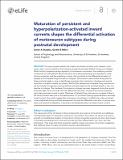Files in this item
Maturation of persistent and hyperpolarization-activated inward currents shapes the differential activation of motoneuron subtypes during postnatal development
Item metadata
| dc.contributor.author | Sharples, Simon A | |
| dc.contributor.author | Miles, Gareth B | |
| dc.date.accessioned | 2021-12-08T12:30:03Z | |
| dc.date.available | 2021-12-08T12:30:03Z | |
| dc.date.issued | 2021-12-03 | |
| dc.identifier | 276737844 | |
| dc.identifier | 0c656e30-3568-4b15-80dd-7c725fc56825 | |
| dc.identifier | 34783651 | |
| dc.identifier | 85120046337 | |
| dc.identifier.citation | Sharples , S A & Miles , G B 2021 , ' Maturation of persistent and hyperpolarization-activated inward currents shapes the differential activation of motoneuron subtypes during postnatal development ' , eLife , vol. 10 , e71385 . https://doi.org/10.7554/eLife.71385 | en |
| dc.identifier.issn | 2050-084X | |
| dc.identifier.other | ORCID: /0000-0002-8624-4625/work/103510947 | |
| dc.identifier.other | ORCID: /0000-0003-2316-1504/work/103511247 | |
| dc.identifier.uri | https://hdl.handle.net/10023/24489 | |
| dc.description.abstract | The size principle underlies the orderly recruitment of motor units; however, motoneuron size is a poor predictor of recruitment amongst functionally defined motoneuron subtypes. Whilst intrinsic properties are key regulators of motoneuron recruitment, the underlying currents involved are not well defined. Whole-cell patch-clamp electrophysiology was deployed to study intrinsic properties, and the underlying currents, that contribute to the differential activation of delayed and immediate firing motoneuron subtypes. Motoneurons were studied during the first three postnatal weeks in mice to identify key properties that contribute to rheobase and may be important to establish orderly recruitment. We find that delayed and immediate firing motoneurons are functionally homogeneous during the first postnatal week and are activated based on size, irrespective of subtype. The rheobase of motoneuron subtypes become staggered during the second postnatal week, which coincides with the differential maturation of passive and active properties, particularly persistent inward currents. Rheobase of delayed firing motoneurons increases further in the third postnatal week due to the development of a prominent resting hyperpolarization-activated inward current. Our results suggest that motoneuron recruitment is multifactorial, with recruitment order established during postnatal development through the differential maturation of passive properties and sequential integration of persistent and hyperpolarization-activated inward currents. | |
| dc.format.extent | 18416328 | |
| dc.language.iso | eng | |
| dc.relation.ispartof | eLife | en |
| dc.subject | Motoneuron | en |
| dc.subject | Spinal cord | en |
| dc.subject | Recruitment | en |
| dc.subject | Size principle | en |
| dc.subject | Intrinsic properties | en |
| dc.subject | Postnatal development | en |
| dc.subject | Electrophysiology | en |
| dc.subject | RC0321 Neuroscience. Biological psychiatry. Neuropsychiatry | en |
| dc.subject | DAS | en |
| dc.subject.lcc | RC0321 | en |
| dc.title | Maturation of persistent and hyperpolarization-activated inward currents shapes the differential activation of motoneuron subtypes during postnatal development | en |
| dc.type | Journal article | en |
| dc.contributor.sponsor | The Royal Society | en |
| dc.contributor.institution | University of St Andrews. School of Psychology and Neuroscience | en |
| dc.contributor.institution | University of St Andrews. Institute of Behavioural and Neural Sciences | en |
| dc.identifier.doi | https://doi.org/10.7554/eLife.71385 | |
| dc.description.status | Peer reviewed | en |
| dc.identifier.grantnumber | NIF/R1/180091 | en |
This item appears in the following Collection(s)
Items in the St Andrews Research Repository are protected by copyright, with all rights reserved, unless otherwise indicated.

